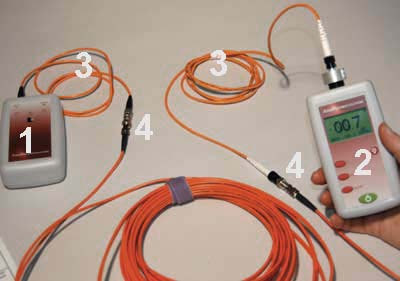Innovative robotic vision solutions improve automation and precision.
Checking Out the Perks of Optical Fibre Checking for Enhanced Communication Systems
The significance of optical fibre testing in contemporary communication systems can not be overstated, as it serves as a foundation for making sure network dependability and performance. This positive testing method has profound ramifications for signal high quality and functional performance, elevating the inquiry of how these methods add to long-lasting sustainability in an ever-evolving technical landscape.
Importance of Optical Fibre Screening
The significance of optical fiber testing can not be overstated in today's data-driven atmosphere. As organizations increasingly rely upon high-speed information transmission for everyday procedures, the integrity and performance of optical fibre networks are paramount. Evaluating makes certain that these networks can support the huge quantities of information produced and transferred perfectly, fostering efficient communication and connectivity.
Optical fibre screening offers several important features, consisting of validating installment top quality, determining prospective faults, and determining total system efficiency. Regular testing can prevent expensive downtimes and service disturbances, allowing companies to preserve operational continuity. It assists in conformity with industry requirements and regulations, making sure that fiber optic setups meet needed specs for safety and security and reliability.
Furthermore, screening can boost the longevity of fiber optic systems. By proactively determining concerns such as signal loss, depletion, or adapter failures, companies can resolve troubles prior to they escalate, hence prolonging the life of their infrastructure. In recap, optical fibre screening is not merely a technological requirement yet a calculated investment that enhances network dependability, maximizes efficiency, and inevitably sustains the growth and efficiency of modern communication systems.
Key Testing Techniques

OTDR is an important strategy used to determine mistakes, step splice losses, and assess the general stability of a fibre optic web link. By sending a pulse of light down the fibre and examining the shown light, technicians can determine places of mistakes and evaluate the network's efficiency over fars away.
Insertion loss screening gauges the amount of signal loss that happens when light go through a link or splice. This approach is vital for validating that connections satisfy given loss thresholds, which is vital for preserving optimum performance in interaction systems.
Optical return loss testing evaluates the amount of light reflected back in the direction of the source because of imperfections in the fiber or links. High return loss values suggest far better efficiency and minimized signal deterioration.
Together, these screening techniques supply an extensive analysis of helpful site fibre optic networks, guaranteeing their integrity and functionality in varied communication applications.
Effect On System Performance
Efficient optical fiber screening straight influences the general performance of communication systems. By ensuring the integrity of fibre optic wires, screening recognizes potential faults such as attenuation, splice loss, and port imbalance. These issues can substantially deteriorate signal top quality, causing interruptions and lowered data transmission rates.

In addition, routine optical fibre screening adds to long-lasting system sustainability. It makes it possible for early discovery of wear and tear, allowing for prompt upkeep and upgrades prior to major failures take place. This not only lengthens the lifespan of the framework but additionally makes sure that interaction systems stay competitive in terms of efficiency.
Cost-Effectiveness and Performance
Cost-effectiveness is a vital consideration in the deployment and upkeep of optical fiber networks. Implementing robust optical fibre testing treatments can substantially minimize operational costs by identifying problems prior to they escalate into major problems. ofda. By finding mistakes, depletion, and other efficiency limitations early, companies can stay clear of costly repair work and downtime, which can interrupt solutions and cause profits loss
In addition, reliable testing approaches streamline the setup process, enabling professionals to work a lot more successfully. This equates to reduce work costs and faster job completion times. Advanced testing tools, such as Optical Time Domain Reflectometers (OTDRs), enables a precise assessment of fibre top quality, making certain that only optimum materials are made use of, thereby decreasing waste.
Routine testing also adds to better source appropriation. By understanding the network's efficiency, companies can make informed choices regarding upgrades and developments, making sure that financial investments are made where they are most required. In recap, optical fiber screening enhances cost-effectiveness and effectiveness, sustaining the long-term sustainability and competitiveness of interaction systems in an increasingly demanding market.
Guaranteeing Long-Term Integrity
Applying rigorous optical fibre screening not just enhances price financial savings and click functional effectiveness but additionally plays a critical duty in making certain the long-lasting dependability of interaction networks. Regular screening practices, including depletion and transmission capacity assessments, aid determine possible degradation in fibre efficiency before it brings about service disruptions.
By utilizing innovative screening approaches, network drivers can determine mistakes or weaknesses in the fiber framework, permitting timely removal. This positive strategy minimizes downtime, making sure that interaction systems continue to be functional and efficient. Normal screening adds to the advancement of an extra resilient network, as drivers can adjust and maximize their infrastructure based on real-time data understandings.
Furthermore, guaranteeing conformity with industry requirements with optical fiber testing reinforces the quality and stability of the whole communication system. This adherence not only boosts self-confidence amongst stakeholders yet likewise lines up with governing demands, which are significantly strict.
Verdict
In verdict, optical fiber screening serves as an essential part in enhancing interaction systems. By using numerous testing techniques, such as OTDR and insertion loss analyses, networks can attain ideal performance and dependability. The proactive recognition of mistakes not just boosts signal top quality but likewise decreases downtime, inevitably adding to cost-effectiveness and operational efficiency. Adherence to market standards promotes stakeholder self-confidence, guaranteeing the long-term sustainability of interaction infrastructures in an increasingly data-driven landscape.